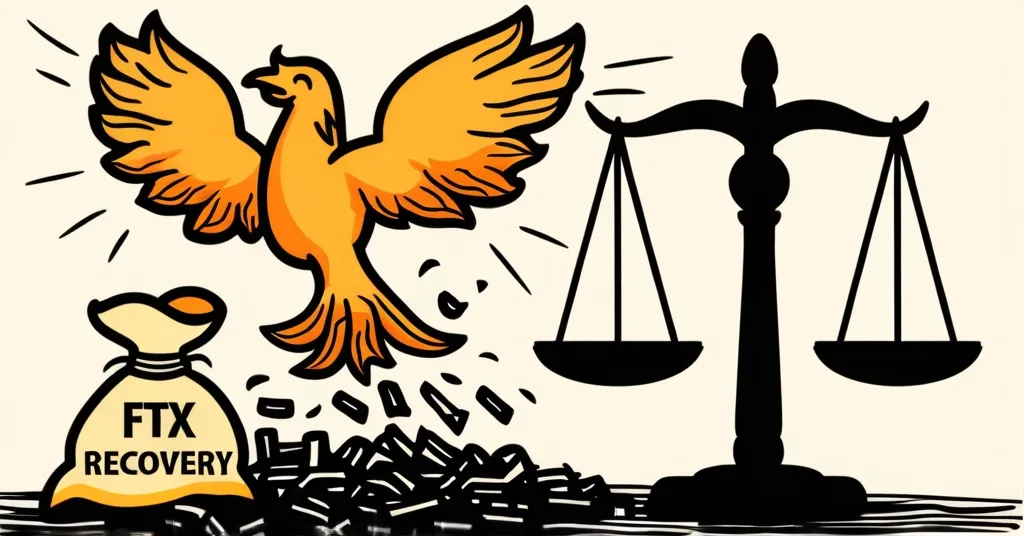FTX Begins Creditor Payouts: Recovery Underway with Challenges Ahead

FTX Initiates Payouts to Creditors: The Path to Recovery
FTX has embarked on a crucial stage of its recovery process by beginning to distribute funds to creditors with claims under $50,000, aided by Kraken and BitGo. This development offers a glimmer of hope to those impacted by the exchange’s collapse, yet it’s shadowed by ongoing controversy and user dissatisfaction.
- FTX pays out creditors with claims under $50,000
- 119% of claim value distributed, including interest
- Next distribution set for May 30
FTX’s journey from a leading cryptocurrency exchange to its dramatic collapse under the weight of fraud and mismanagement has been a rollercoaster. The exchange is now attempting to make amends by paying out creditors whose claims are below $50,000. These creditors are receiving approximately 119% of their claim value, which includes a 9% annual interest rate accrued since November 2022. This effort is supported by Kraken and BitGo, who convert these payouts into US dollars. To receive their share, creditors must undergo Know Your Customer (KYC) verification and submit necessary tax forms.
The initial optimism around these payouts is tempered by the reality that the next distribution, planned for May 30, will address larger claim categories, including “Class 5 Customer Entitlement Claims” and “Class 6 General Unsecured Claims.” These categories are expected to receive between $14.5 billion and $16.3 billion. This move is part of a broader initiative to utilize around $16.5 billion in recovered assets to compensate customers. Discussions with the US Department of Justice continue regarding an additional $1 billion in seized assets, while shareholders are slated to receive up to $230 million.
Despite these efforts, not all customers are pleased. Some express frustration over the timing of FTX’s collapse, which prevented them from capitalizing on subsequent cryptocurrency price surges. The irony of receiving payouts in dollars, rather than the original crypto assets, is particularly galling when considering that at the time of its bankruptcy, FTX held only 0.1% of the Bitcoin that customers believed they had deposited. This discrepancy has sparked criticism and demands for more than just monetary compensation.
The shadow of Sam Bankman-Fried, FTX’s co-founder, looms large over the recovery process. Convicted of fraud and sentenced to 25 years in prison in March 2024, his actions have left a deep mark on the crypto community. His conviction is a stark reminder of the industry’s darker sides, yet it also drives the push for stronger regulations and more transparent practices.
As FTX navigates this intricate recovery process, opinions among users remain divided. The current payouts mark progress, yet the inability to return the original crypto assets remains a point of contention. This situation underscores the inherent challenges and risks in the cryptocurrency world, but also highlights the resilience and potential for recovery within the sector.
Amid these developments, FTT, FTX’s native token, was trading at $1.93 at the time of writing, reflecting a 7% loss over the month but a 12% gain year-to-date. This fluctuation illustrates that the crypto market continues to evolve, driven by both innovation and speculation.
“Our work is not over — we intend to continue our recovery efforts and return funds to additional claim classes.” – John J. Ray III, plan administrator of the FTX Recovery Trust.
“Creditors must have verified their claims by the record date of April 11 to qualify for the upcoming distribution.” – Sunil Kavuri, an FTX creditor and advocate.
The FTX recovery process is a testament to the resilience within the crypto ecosystem, yet it also serves as a cautionary tale. While the distribution of funds is a step forward, it’s clear that the road to full recovery is long and fraught with challenges. The industry must learn from such failures to build a more secure and trustworthy future.
At the same time, the crypto space continues to push boundaries, with projects like Bitcoin leading the charge towards decentralization and financial freedom. While FTX’s plight highlights the risks, it’s important to remember that the broader mission of cryptocurrencies—to disrupt the status quo and empower individuals—remains as vital as ever. The balance between optimism and realism is crucial as we navigate the complexities of this evolving landscape.
Key Takeaways and Questions:
- What is the status of FTX’s recovery efforts?
FTX has started distributing funds to creditors with claims under $50,000, facilitated by Kraken and BitGo, with the next distribution targeting larger claims set for May 30.
- How much are creditors receiving as part of the current distribution?
Creditors with claims under $50,000 are receiving approximately 119% of their claim value, including a 9% annual interest rate since November 2022.
- What steps must creditors take to receive their payouts?
Creditors must complete KYC verification, submit required tax forms, and onboard with either BitGo or Kraken to receive their payouts.
- What are the estimated values for the upcoming distribution in May?
The estimated value of the May distribution ranges between $14.5 billion and $16.3 billion.
- Why are some FTX customers dissatisfied with the repayment plan?
Some customers are dissatisfied because the collapse of FTX prevented them from benefiting from the subsequent rise in cryptocurrency prices.
- What was the outcome of Sam Bankman-Fried’s trial?
Sam Bankman-Fried was convicted of fraud and sentenced to 25 years in prison in March 2024.
- How much of the Bitcoin did FTX actually hold at the time of its bankruptcy?
At the time of its bankruptcy filing, FTX reportedly held only 0.1% of the Bitcoin that customers believed they had deposited on the platform.
- What is the current trading status of FTT?
At the time of writing, FTT was trading at $1.93, with losses of 7% over the month but gains of 12% year-to-date.



